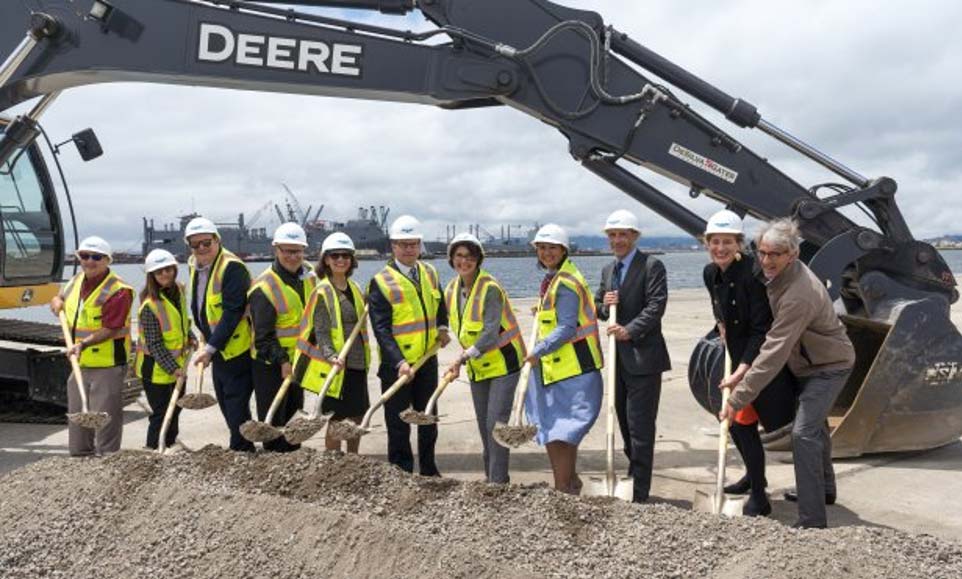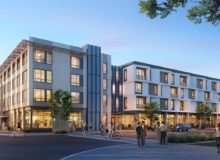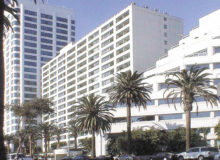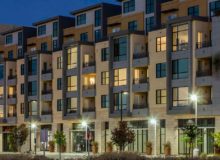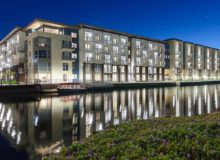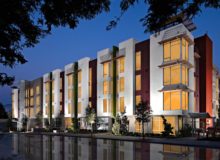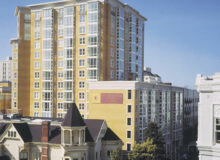GlobeSt
May 30, 2018
By Lisa Brown
Site A and all of its infrastructure, parks and housing, is just the beginning, as Alameda sets its sights on bringing a tech campus to the historic Bachelor Enlisted Quarters to foster job generation in the Enterprise District.
ALAMEDA, CA—Memorial Day celebrations are in the not-too-distant rear-view mirror, which is an appropriate coincidence for the start of development on the former Naval Air Station site. Alameda and its private partner, Alameda Point Partners LLC, recently celebrated the groundbreaking of the first phase of the $1 billion mixed-use transit-oriented waterfront development at the gateway to Alameda Point called Site A. The 68-acre development is located on the site of the former Naval Air Station Alameda which closed more than 20 years ago.
“I am thoroughly impressed with how much city pride the residents and officials of the city of Alameda have and it has clearly shined through in our dealing with the stakeholders,” Bruce Dorfman, senior managing director of Trammell Crow Residential’s Northern California division, tells GlobeSt.com. “Alameda Point Site A has been such a tremendous group effort. So many stakeholders have come together to make this project happen. This speaks volumes about how great the community of Alameda is. At the groundbreaking ceremony, I was thinking about how pleased, honored and privileged we feel to be able to develop in this community and to build the first multifamily market-rate apartment community in 45 years.”
Alameda Point Partners is a joint venture led by managing partner Trammell Crow Residential, a division of Dallas-based Crow Holdings, and also includes commercial developer srmERNST Development Partners, affordable nonprofit housing developer Eden Housing, retail landlord Madison Marquette and financial partner, Cypress Equity Investments.
Projected to cost $500 million, the first phase of the Site A project consists of 673 housing units, including 130 units of affordable housing for low and very-low income households, and an additional 310 units affordable to middle-income households, 8 acres of parks and open space, nearly 100,000 square feet of retail and dining spaces, and space for community events and gatherings. Major infrastructure improvements on the 30-acre phase one project include new water, sewer, electrical and gas lines, newly paved streets with bike and transit lanes, and bulkhead improvements on Seaplane Lagoon for the new ferry terminal.
Completion of the infrastructure for phase one is expected within the next two years, with vertical construction commencing by year end. The first residential units are projected to be completed in the second half of 2019. One of the mandates for this development is to build 25% of the residential units with affordable and below-market rate housing. This is higher than most cities in the Bay Area require but the need is at a critical point here for all levels of affordability.
Transit is another key issue that Site A will address. The development’s goal is to reduce automobile dependency and improve alternative transportation modes by encouraging people to shift a greater share of trips to public transit, biking and walking. Thus, the developers are making a considerable investment in transit infrastructure with a package of multi-modal strategies that complement and build off each other, including the new ferry terminal with service to San Francisco in early 2020, bus rapid transit, last-mile connection to BART (with bus service every 15 minutes in peak periods), and bike and car sharing.
Sustainability is another priority. All buildings will be constructed with a LEED-Gold Certified rating or equivalent by the US Green Building Council. These standards ensure a reduction of greenhouse gases from building heating, cooling and operations. All Site A structures will be solar ready and meet the latest California building standards codes for solar photovoltaic. All parking facilities will include electric-vehicle charging stations.
The project represents the first major public-private development at Alameda Point since Naval Air Station Alameda closed in 1997, resulting in the loss of 18,000 jobs. The project will create approximately 2,500 direct construction jobs during the life of the project and serve as the catalyst for thousands of future jobs.
When asked what’s next for the city, Jennifer Ott, director of base reuse and transportation for the city of Alameda said, “Site A and all of its infrastructure, parks, housing and other amenities are just the beginning. We look forward to bringing a tech campus to the historic Bachelor Enlisted Quarters, establishing new job-generating leases and deals in our Enterprise District to attract high-paying jobs for our local workforce, and re-building our existing supportive housing in new state-of-the-art facilities.”

